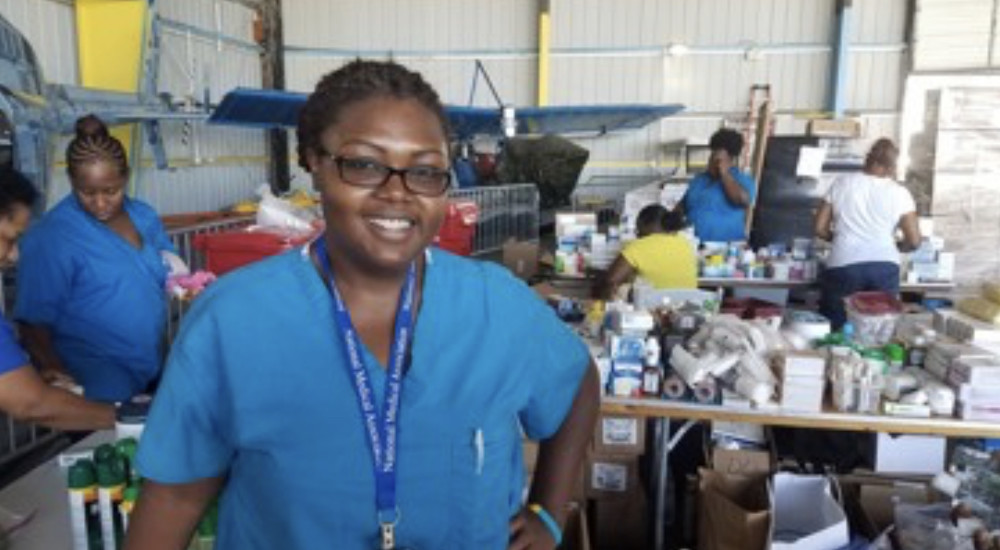By Gracie Bonds Staples
The Atlanta Journal-Constitution
WWR Article Summary (tl;dr) Dr. Shaneeta Johnson will not rest until the people of the Bahamas have the medical care they need. Every community clinic on the entire eastern side of the Grand Bahama Island was demolished during Hurricane Dorian.
The Atlanta Journal-Constitution
Any day now, a Delta Air Lines plane will head back to the Bahamas stocked with some 10,000 pounds of badly needed medical supplies.
Compared to the devastation wrought by Hurricane Dorian, that might not look like much, but rest assured Dr. Shaneeta Johnson is by no means done.
She is heading efforts to collect more supplies. With help from Delta, Morehouse School of Medicine, Emory, WSB-TV, and the Bahamas Consulate in Atlanta, more shipments will follow, along with more medical personnel and, since every community clinic on the entire eastern side of the Grand Bahama Island was demolished, a mobile clinic will be added. You can give online at crowdfunding.msm.edu/project/16635.
“We’d like to assist with the short-term care of patients but also with the long-term reoutfitting of the Rand Memorial Hospital with equipment so that it is functional again,” she said.
In a conference room at Morehouse Healthcare last week, Johnson was still moved by the devastation she’d witnessed, but each dark memory was countered by the generosity and strength of the people she met.
Dorian tracked only about 25 miles in 24 hours. It was the shortest distance traveled by an Atlantic major hurricane in that period of time, experts said, since Hurricane Betsy hit in 1965.
Johnson, a native of Nassau, watched spellbound as it strengthened and then stalled over Abaco and Grand Bahama, pummeling the islands with wind speeds of over 185 miles per hour and water surges topping 20 feet.
“I remember getting photos from friends and family of the destruction,” Johnson said. “Then the calls started coming in of those that were missing and those we’d lost communication with and didn’t know their status. We were praying and hoping for a good result.”
The calls continued over the next several days, when most of the people Johnson was in contact with had found their loved ones, including a friend’s daughter, but thousands were still missing.
Johnson, a bariatric surgeon and faculty member at the Morehouse School of Medicine, began looking for ways to help, joining several medical relief teams and collecting badly needed medical supplies.
Within 72 hours, she’d collected some 200 pounds of medical supplies, syringes, gauzes, gowns, antibiotics and saline, donated by Morehouse Healthcare, the Morehouse School of Medicine and Emory.
On Sept. 8, seven days after the hurricane hit, Johnson arrived in Nassau and then to what was considered ground zero for the evacuation, Odyssey Airport. Thousands of evacuees were being brought in on relief flights, then fed, triaged and given medical care.
The next day, Johnson arrived in Grand Bahama, which had sustained 48 hours of damage. The airport terminals had been swept away with the wind. Planes were broken into half. From the tarmac, which had no control tower, she and the rest of the relief team were bused into downtown and then taken to the main hospital.
“There it dawned on us the devastation,” Johnson said. “The island was without water or electricity. The Rand Memorial Hospital, which had sustained significant damage, went from roughly 100 beds to 10 usable beds. The operating theater and medical surgical wing were flooded. The emergency room, a little higher, sustained less damage, so that’s where most patients were.”
Johnson and the other doctors met with the local medical team there and then headed to a field hospital that was being erected across the street, a 40-bed tent facility with emergency and operating rooms.
Over the next several days, they would assist with patient care there and at community clinics, where there was no running water.
“I met patients who had lost everything,” Johnson said.
One of them, a 13-year-old boy who had been pinned against a wall of his home, suffered various lacerations to his body. His left foot and left arm were sliced open.
As night fell, the team fanned out across more devastated communities like High Rock and Pelican Point, where all the health clinics had been demolished. They went from home to home giving medical and humanitarian aid, food and water.
“We took blood pressure. We dressed wounds. We gave antibiotics and food,” Johnson said.
She remembered meeting a woman sitting in a car with her mother and four young children, and flagging her down, then pleading for her to take the grandmother’s blood pressure. Their homes had been swept off their foundation as if they never existed.
The women were visibly moved by the young physician’s generosity.
Johnson couldn’t imagine being anyplace else, doing anything else. For her, this was personal. This was home.
She had grown up less than 135 miles from here in Nassau, the oldest of three children born to educators.
After graduating from high school in 1995, Johnson earned a bachelor of arts degree in neuroscience from Johns Hopkins University before heading west to Loma Linda University School of Medicine. She graduated in 2003 and then completed a general surgery residency at Howard University Hospital.
She joined the Morehouse School of Medicine in 2016, after completing a fellowship in minimally invasive and bariatric surgery at the Cleveland Clinic and working at Southern Regional.
To see that level of devastation in such a beautiful place was unreal.
“It almost felt like a movie, like it couldn’t possibly be,” Johnson said.
She was struck by the number of people who arrived from around the world to help. She remembers the smiles and the tears. There were a lot of both.
Even now, the memories can summon tears, but Johnson can’t give in to her emotions. She has too much work yet to do.
___
Distributed by Tribune Content Agency, LLC.














































































































































































































































































































































































